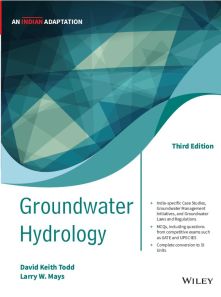Groundwater Hydrology, 3ed (An Indian Adaptation)
ISBN: 9788194726333
560 pages
For more information write to us at: acadmktg@wiley.com

Description
Groundwater Hydrology is a classic textbook that provides a unified presentation of groundwater hydrology, treating fundamental principles, methods, and problems encountered in the field as a whole. Continuing its forty-year history of providing students and professionals with a thorough grounding in the science and technology of groundwater hydrology, the book explores the many new developments that have occurred in the groundwater field in recent years, concerns and competition for water supplies, contamination of groundwater, and enhanced regulation of water resources. The book also focuses on modern groundwater modeling tools, including a detailed description of MODFLOW.
1. Introduction
1.1 Scope
1.2 Historical Background
1.3 Trends in Water Withdrawals and Use
1.4 Utilization of Groundwater
1.5 Groundwater in the Hydrologic Cycle
1.6 Hydrologic Budget Case Study—Lake Five-O, Florida
1.7 Publication Sources
1.8 Data Sources
2. Occurrence Of Groundwater
2.1 Origin and Age of Groundwater
2.2 Rock Properties Affecting Groundwater
2.3 Vertical Distribution of Groundwater
2.4 Zone of Aeration
2.5 Zone of Saturation
2.6 Geologic Formations as Aquifers
2.7 Types of Aquifers
2.8 Storage Coefficient
2.9 Groundwater Basins/Regional Groundwater Flow Systems
2.10 Springs
3. Groundwater Movement
3.1 Darcy’s Law
3.2 Permeability
3.3 Determination of Hydraulic Conductivity
3.4 Anisotropic Aquifers
3.5 Groundwater Flow Rates
3.6 Groundwater Flow Directions
3.7 General Flow Equations
3.8 Unsaturated Flow
3.9 Kinematic Wave
3.10 Infiltration: The Green–Ampt Method
3.11 Double Ring Infiltrometer
4. Groundwater And Well Hydraulics
4.1 Steady Unidirectional Flow
4.2 Steady Radial Flow to a Well
4.3 Well in a Uniform Flow
4.4 Unsteady Radial Flow in a Confined Aquifer
4.5 Unsteady Radial Flow in an Unconfined Aquifer
4.6 Unsteady Radial Flow in a Leaky Aquifer
4.7 Well Flow Near Aquifer Boundaries
4.8 Multiple Well Systems
4.9 Partially Penetrating Wells
4.10 Well Flow for Special Conditions
5. Water Wells
5.1 Test Holes and Well Logs
5.2 Methods for Constructing Shallow Wells
5.3 Methods for Drilling Deep Wells
5.4 Well Completion
5.5 Well Development
5.6 Testing Wells for Yield
5.7 Pumping Equipment
5.8 Protection of Wells
5.9 Well Rehabilitation
5.10 Horizontal Wells
5.11 Characteristic Well Losses
5.12 Specific Capacity and Well Efficiency
5.13 Slug Tests
6. Groundwater Levels And Environmental Influences
6.1 Time Variations of Levels
6.2 Streamflow and Groundwater Levels
6.3 Fluctuations Due to Evapotranspiration
6.4 Fluctuations Due to Meteorological Phenomena
6.5 Fluctuations Due to Tides
6.6 Urbanization
6.7 Earthquakes
6.8 External Loads
6.9 Effects of Global Climate Change On Groundwater
7. Quality Of Groundwater
7.1 Natural Groundwater Quality
7.2 Sources of Salinity
7.3 Measures of Water Quality
7.4 Chemical Analysis
7.5 Graphical Representations
7.6 Physical Analysis
7.7 Biological Analysis
7.8 Groundwater Samples
7.9 Water-Quality Criteria
7.10 Changes in Chemical Composition
7.11 Dissolved Gases
7.12 Temperature
7.13 Saline Groundwater
7.14 Monitoring Groundwater Quality
7.15 Solute Transport in Saturated Porous Media
7.16 Dispersion
7.17 Advection–Dispersion Equation for Solute Transport in Saturated Porous Media
7.18 Groundwater Tracers
8. Pollution Of Groundwater
8.1 Pollution in Relation to Water Use
8.2 Municipal Sources and Causes and Causes
8.4 Agricultural Sources and Causes
8.5 Miscellaneous Sources and Causes
8.6 Attenuation of Pollution
8.7 Distribution of Pollution Underground
8.8 Remediation of Contaminated Groundwater
8.9 Conventional Pump-and-Treatment Systems
9. Groundwater Flow Modeling Techniques
9.1 Why Develop Groundwater Models?
9.2 Types of Groundwater Models
9.3 Steps in the Development of a Groundwater Model
9.4 Simulation of Two-Dimensional Groundwater Systems
9.5 Three-Dimensional Groundwater Flow Model
9.6 Tools for Numerical Groundwater Modeling
9.7 Case Study—Using MODFLOW: Lake Five-O, Florida
9.8 Example Applications and Input of MODFLOW
9.9 Groundwater Modeling Software Support
10. Management Of Groundwater
10.1 Concepts of Basin Management
10.2 Groundwater Basin Investigations and Data Collection
10.3 Yield
10.4 Conjunctive Use and Watershed Management
10.5 Groundwater Management: Water Laws and Policies
10.6 Groundwater Management: Initiatives in India
10.7 Groundwater Management Using Models
11. Surface Investigations Of Groundwater
11.1 Geologic Methods
11.2 Remote Sensing
11.3 Geophysical Exploration
11.4 Electrical Resistivity Method
11.5 Seismic Refraction Method
11.6 Gravity and Magnetic Methods
12. Subsurface Investigations Of Groundwater
12.1 Test Drilling
12.2 Water-Level Measurement
12.3 Geophysical Logging
12.4 Resistivity Logging
12.5 Spontaneous Potential Logging
12.6 Radiation Logging
12.7 Temperature Logging
12.8 Caliper Logging
12.9 Fluid-Conductivity Logging
12.10 Fluid-Velocity Logging
12.11 Miscellaneous Logging Techniques
12.12 Other Subsurface Methods
12.13 Case Study
13. Artificial Recharge Of Groundwater
13.1 Concept of Artificial Recharge
13.2 Recharge Methods
13.3 Wastewater Recharge For Reuse
13.4 Soil Aquifer Treatment (SAT) Systems
13.5 Innovative Approaches
13.6 Induced Recharge
14. Saline Water Intrusion In Aquifers
14.1 Occurrence of Saline-Water Intrusion
14.2 Ghyben–Herzberg Relation Between Fresh and Saline Waters
14.3 Shape of the Fresh–Saltwater Interface
14.4 Structure of the Fresh–Saltwater Interface
14.5 Effect of Wells on Seawater Intrusion
14.6 Upconing of Saline Water
14.7 Fresh–Saltwater Relations on Oceanic Islands
14.8 Seawater Intrusion in Karst Terrains
14.9 Control of Saline-Water Intrusion
14.10 Examples of Seawater Intrusion
Problems
References
Multiple Choice Questions
Appendix A: Metric Units and English Equivalents
Appendix B: List of Websites and Nongovernmental Organizations
Appendix C: Modflow Input and Output Data for Examples in Chapter 9
Index
Supplements

